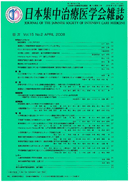Volume 15, Issue 2
Displaying 1-26 of 26 articles from this issue
- |<
- <
- 1
- >
- >|
HIGHLIGHT IN THE ISSUE
-
2008Volume 15Issue 2 Pages 151-152
Published: April 01, 2008
Released on J-STAGE: November 01, 2008
Download PDF (538K) -
2008Volume 15Issue 2 Pages 153-155
Published: April 01, 2008
Released on J-STAGE: November 01, 2008
Download PDF (635K) -
2008Volume 15Issue 2 Pages 156-157
Published: April 01, 2008
Released on J-STAGE: November 01, 2008
Download PDF (518K) -
2008Volume 15Issue 2 Pages 157-159
Published: April 01, 2008
Released on J-STAGE: November 01, 2008
Download PDF (526K) -
2008Volume 15Issue 2 Pages 160-164
Published: April 01, 2008
Released on J-STAGE: November 01, 2008
Download PDF (537K) -
2008Volume 15Issue 2 Pages 164-166
Published: April 01, 2008
Released on J-STAGE: November 01, 2008
Download PDF (524K) -
2008Volume 15Issue 2 Pages 166-167
Published: April 01, 2008
Released on J-STAGE: November 01, 2008
Download PDF (517K) -
2008Volume 15Issue 2 Pages 168-169
Published: April 01, 2008
Released on J-STAGE: November 01, 2008
Download PDF (225K)
COMMENTARY ARTICLE
-
2008Volume 15Issue 2 Pages 171-178
Published: April 01, 2008
Released on J-STAGE: November 01, 2008
Download PDF (980K) -
2008Volume 15Issue 2 Pages 179-188
Published: April 01, 2008
Released on J-STAGE: November 01, 2008
Download PDF (719K)
ORIGINAL ARTICLE
-
2008Volume 15Issue 2 Pages 189-195
Published: April 01, 2008
Released on J-STAGE: November 01, 2008
Download PDF (874K) -
2008Volume 15Issue 2 Pages 197-204
Published: April 01, 2008
Released on J-STAGE: November 01, 2008
Download PDF (999K)
NURSING ORIGINAL ARTICLE
-
2008Volume 15Issue 2 Pages 205-212
Published: April 01, 2008
Released on J-STAGE: November 01, 2008
Download PDF (474K)
CASE REPORT
-
2008Volume 15Issue 2 Pages 213-218
Published: April 01, 2008
Released on J-STAGE: November 01, 2008
Download PDF (560K) -
2008Volume 15Issue 2 Pages 219-222
Published: April 01, 2008
Released on J-STAGE: November 01, 2008
Download PDF (337K)
BRIEF REPORT
-
2008Volume 15Issue 2 Pages 223-224
Published: April 01, 2008
Released on J-STAGE: November 01, 2008
Download PDF (300K) -
2008Volume 15Issue 2 Pages 225-226
Published: April 01, 2008
Released on J-STAGE: November 01, 2008
Download PDF (247K) -
2008Volume 15Issue 2 Pages 227-228
Published: April 01, 2008
Released on J-STAGE: November 01, 2008
Download PDF (271K) -
2008Volume 15Issue 2 Pages 229-230
Published: April 01, 2008
Released on J-STAGE: November 01, 2008
Download PDF (298K) -
2008Volume 15Issue 2 Pages 231-232
Published: April 01, 2008
Released on J-STAGE: November 01, 2008
Download PDF (306K) -
2008Volume 15Issue 2 Pages 233-234
Published: April 01, 2008
Released on J-STAGE: November 01, 2008
Download PDF (303K) -
2008Volume 15Issue 2 Pages 235-236
Published: April 01, 2008
Released on J-STAGE: November 01, 2008
Download PDF (595K) -
2008Volume 15Issue 2 Pages 237-238
Published: April 01, 2008
Released on J-STAGE: November 01, 2008
Download PDF (618K) -
2008Volume 15Issue 2 Pages 239-240
Published: April 01, 2008
Released on J-STAGE: November 01, 2008
Download PDF (767K)
LETTER
-
2008Volume 15Issue 2 Pages 241-242
Published: April 01, 2008
Released on J-STAGE: November 01, 2008
Download PDF (215K) -
2008Volume 15Issue 2 Pages 243-244
Published: April 01, 2008
Released on J-STAGE: November 01, 2008
Download PDF (432K)
- |<
- <
- 1
- >
- >|
